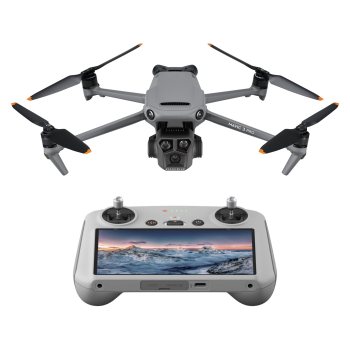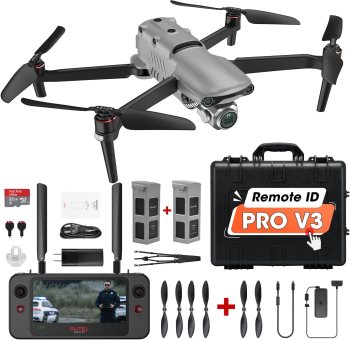- Exceptional image quality
- Long flight time
- Advanced safety features
- Unmatched video resolution
- High-quality camera sensor
- Extended flight time
- Comprehensive flight modes
- High price point
- Complex for beginners
- Expensive
- Complex for beginners
DJI Mavic 3 Pro vs Autel Robotics EVO II Pro
The world of photography drones has witnessed significant advancements in recent years, with top manufacturers like DJI and Autel Robotics pushing the boundaries of innovation. Two high-end models that have garnered considerable attention are the DJI Mavic 3 Pro and the Autel Robotics EVO II Pro. In this comparison, we'll delve into the features, specifications, and performance of these two photography drones to help you decide which one best suits your needs.
Design and Build
The DJI Mavic 3 Pro boasts a sleek and compact design, weighing in at approximately 1.97 pounds (895 grams). Its folding mechanism allows for easy transportation and storage, making it an ideal choice for photographers and videographers on the go. The drone's airframe is constructed from high-quality materials, ensuring durability and resistance to harsh weather conditions.
In contrast, the Autel Robotics EVO II Pro has a slightly larger and heavier design, tipping the scales at around 2.75 pounds (1,249 grams). While it may not be as portable as the Mavic 3 Pro, the EVO II Pro's sturdy build and reinforced airframe provide exceptional stability and protection against rough handling.
Camera Capabilities
Both drones are equipped with high-quality cameras, but they differ in terms of specifications and features. The DJI Mavic 3 Pro sports a 1-inch CMOS sensor with a 24mm equivalent focal length, capable of capturing 20-megapixel still images and 5.1K video at 50fps. The camera also features an adjustable aperture (f/2.8-f/11) and a 12.8-stop dynamic range.
The Autel Robotics EVO II Pro, on the other hand, boasts a 1-inch CMOS sensor with a 24mm equivalent focal length, producing 20-megapixel still images and 8K video at 25fps. The camera's adjustable aperture ranges from f/2.8 to f/16, and it offers a 13-stop dynamic range. While both cameras are exceptional, the EVO II Pro's 8K video capability gives it a slight edge in terms of resolution.
Flight Performance
When it comes to flight performance, both drones excel in different areas. The DJI Mavic 3 Pro has a maximum speed of 47mph (75kph) and can withstand winds up to 38mph (61kph). Its advanced obstacle avoidance system, featuring a combination of GPS, GLONASS, and vision sensors, ensures safe and stable flight.
The Autel Robotics EVO II Pro, while not as fast as the Mavic 3 Pro, boasts an impressive maximum speed of 44mph (71kph) and can handle winds up to 33mph (53kph). Its dual-sensor obstacle avoidance system provides excellent stability and collision prevention.
Battery Life and Range
The DJI Mavic 3 Pro has a battery life of up to 46 minutes, depending on the flight mode and conditions. Its transmission range extends up to 9.3 miles (15 kilometers), providing a reliable connection between the drone and its remote controller.
In comparison, the Autel Robotics EVO II Pro offers a battery life of up to 30 minutes and a transmission range of up to 5 miles (8 kilometers). While its range may be shorter than the Mavic 3 Pro's, the EVO II Pro's more efficient power management system helps extend its flight time.
Additional Features
Both photography drones come with an array of advanced features, including:
- DJI Mavic 3 Pro: ActiveTrack 4.0, QuickShots, Hyperlapse, and a built-in LED light for low-light conditions.
- Autel Robotics EVO II Pro: Dynamic Tracking, Waypoint Navigation, and a built-in GPS module for precise positioning.
Conclusion
In conclusion, both the DJI Mavic 3 Pro and the Autel Robotics EVO II Pro are exceptional photography drones that cater to different needs and preferences. While the Mavic 3 Pro excels in terms of portability, speed, and obstacle avoidance, the EVO II Pro offers superior camera capabilities, including 8K video resolution.
Ultimately, the choice between these two high-end photography drones depends on your specific requirements and priorities. If you value compactness, speed, and advanced flight features, the DJI Mavic 3 Pro may be the better option. However, if you prioritize camera quality, particularly in terms of resolution and dynamic range, the Autel Robotics EVO II Pro is an excellent choice.
As the world of photography drones continues to evolve, it's exciting to see manufacturers like DJI and Autel Robotics push the boundaries of innovation, providing professionals and enthusiasts alike with cutting-edge tools to capture stunning aerial imagery.

































